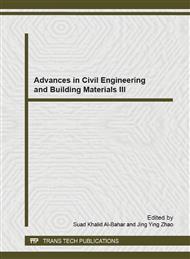p.27
p.32
p.36
p.40
p.44
p.49
p.53
p.58
p.62
AC Impedance and DC Galvanic Current for Monitoring Maturity of Cement Mortar and Rebar Corrosion
Abstract:
The maturity behavior of cement mortar specimens with different concrete additives during the 28 day curing period has been examined using the AC Impedance technique. The main focus of this part of the study is to understand the impedance and capacitance behavior of the steel rebar in cement mortar using different additives during the early stages of hydration process. In this respect, two sets of specimens were prepared: One set consist of two graphite electrodes surrounded by a carbon steel rod for AC Impedance measurements. Another set consisted of two carbon steel setup that has been used for monitoring corrosion of two steel reinforcement bars embedded in cylindrical mortar specimens. The specimens are placed in a salt fog (spray) cabinet for 1,000 hrs.Galvanic current between the two coupled electrodes has been measured using zero resistance ammeter (ZRA) to monitor the extent of corrosion. The in-situ measurement was carried out in a sequential manner over a periodical basis of up to 1,000 hrs of salt fog cabinet exposure. Different mortar mixes were studied including ground granulated blast furnace slag (GGBS) and silica fume (microsilica) as additives and calcium nitrite as corrosion inhibitor and chloride as a contamination species. This data helps in understanding the corrosion activities at the rebar-concrete when interface combined with salt fog test according to (ASTM B117), which can be further correlated with the atmospheric and marine corrosion of steel rebars in concrete. The overall results have indicated the tendency of the admixture to show different hydration processes during the early stages of concrete curing. The interfacial impedance spectrums and galvanic current testing clearly identifies and documents this process for each material.
Info:
Periodical:
Pages:
44-48
Citation:
Online since:
December 2013
Authors:
Price:
Сopyright:
© 2014 Trans Tech Publications Ltd. All Rights Reserved
Share:
Citation:


